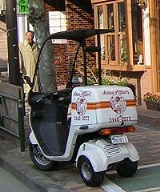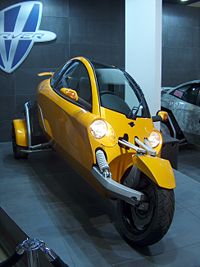
Tilting three wheeler
Encyclopedia

Wheel configurations
Several configurations are practical. Two front wheels and one rear, where all three wheels tilt, use the acronym 2F3T (i.e. two front three tilt). Other variations include 1F1T, where only the front wheel tilts, an example being the Vandenbrink CarverCarver (automobile)
The Carver is a tilting three wheeled vehicle using an automatic balancing technology to balance the passenger compartment under all conditions. The first commercial Carver product, the Carver One, was designed to seat two people, and manufactured and distributed by Carver Europe in the Netherlands...
, made in the Netherlands
Netherlands
The Netherlands is a constituent country of the Kingdom of the Netherlands, located mainly in North-West Europe and with several islands in the Caribbean. Mainland Netherlands borders the North Sea to the north and west, Belgium to the south, and Germany to the east, and shares maritime borders...
.
Active or Passive Tilt Control
With bicycles and motor bikes without enclosure passive tilt control is possible. The rider is responsible for holding the balance.Topology
Propulsion may be on the tilted wheels also with so called tadpolesTadpoles
Tadpoles are a psychedelic rock band formed in 1990 in New York City by Todd Parker , Michael Kite Audino and Josh Bracken In 1992, Nick Kramer , David Max and Andrew Jackson of the fledgling Manhattan group, Hit, joined the Tadpoles after putting Hit on hiatus.In 1993 Kite and Jackson left the...
but requires special controllers when having propulsion on two tilted wheels.
Use of 'extra' wheel

Kickstand
A kickstand is a device on a bicycle or motorcycle that allows the bike to be kept upright without leaning against another object or the aid of a person. A kickstand is usually a piece of metal that flips down from the frame and makes contact with the ground. It is generally located in the middle...
with a caster, employed at low speed. These are called free-leaners and they must be balanced through countersteering
Countersteering
Countersteering is the technique used by single-track vehicle operators, such as cyclists and motorcyclists, to initiate a turn toward a given direction by momentarily steering counter to the desired direction...
(however subconsciously) before turning, just as on a motorcycle or other single-track vehicle. For comfort, the free-leaners are the best for cyclists, as the legs don't get thrown to the side when you hit a bump on one side, and no muscles are used for side support of the torso.
Other tilters use the third wheel to resist wind loads and force a faster lean to set up for a fast corner or emergency lane change. Opinion is divided on how best to control this benefit, however. Some sort of pendulum and servo is the obvious solution, but how to get it to act fast when you need it without chasing every bump? Some think that the driver's anticipation will always be essential in some situations, requiring at least a manual override for the tilting function. Various electric and hydraulic systems have been employed to modify TTW behaviour, with notable success on the Carver. One intriguing possibility is a system that has the driver controlling the tilt only, and the chassis steering accordingly, so the third wheel is well used, and it may be easier to learn for drivers.
Due to the tilting, there is not necessarily any load transfer between the wheels in cornering, so the rule about tadpoles (2F or "reverse trike") understeering and Deltas (1F or standard trike) oversteering does not necessarily apply. Thus deltas are less dangerous, providing that the tilting is done very accurately during hard braking. Tadpoles can still get through more kinds of trouble with grace.
Another system that seems obvious just links tilting to steering angle. This sometimes gets refined to vary the ratio according to speed, but it still is a recipe for disaster in the event of oversteer. It might be safe on a tadpole with a limited range of tilt. That simple arrangement also leaves you sitting awkwardly sideways on camber
Camber
Camber may refer to a variety of curvatures and angles:* Camber angle, the angle made by the wheels of a vehicle* Camber thrust in bike technology* In the steel industry, the concavity of rolls...
ed road edges.
Some tilting three-wheelers use two buttons on the steering wheel connected to an electric motor to allow the driver to adjust the angle of leaning, while some more modern designs use computer-controlled tilting.

